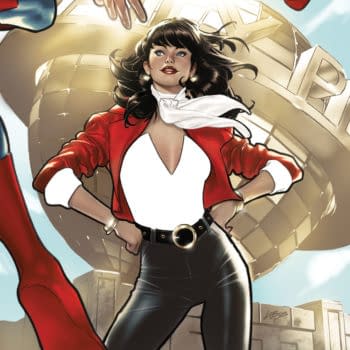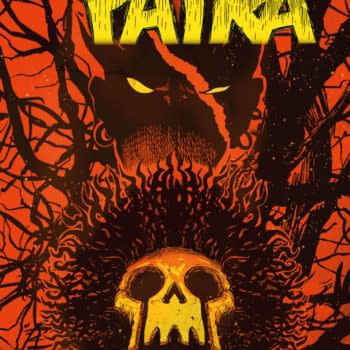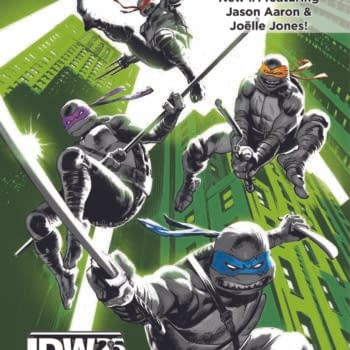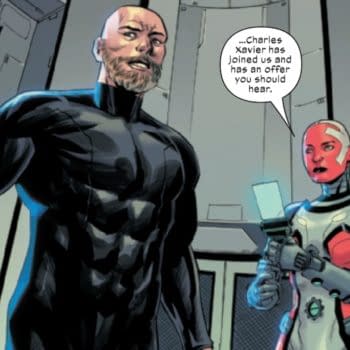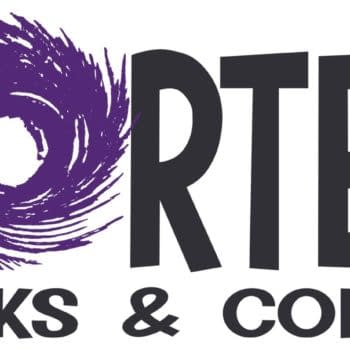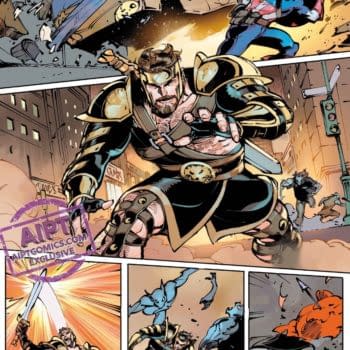Posted in: Comics, Recent Updates | Tagged: Alan Moore, apps, Big Nemo, colleen doran, Comics, digital comics, electricomics, entertainment, garth ennis, john reppion, leah moore, mitch jenkins, nicola scott, Peter Hogan, Peter Snejbjerg, show pieces, Sway, thought bubble
Cracking The Tower Of Babel To Make Electricomics – Leah Moore In The Bleeding Cool Interview At Thought Bubble
Attending Thought Bubble a couple of weeks ago in the UK was an eye-opening experience for me, since it was a much bigger show than I expected and thronged with hundreds of comic creators producing highly original and masterful work. One of the highlights of the Festival for me, and for many of my like-minded friends, was the presence of the team behind the current research and development project Electricomics.
Team members who helped support the Electricomics table at the Festival and were involved in the panel presented at the show, including Leah Moore (Project Manager and comic creator), John Reppion (comic creator), Mitch Jenkins (filmmaker, photographer), Daniel Merlin Goodbrey (expert on digital comics and academic), and Peter Hogan (comic creator). Electricomics is part a digital experiment in comics creating being funded by a NESTA grant in the UK which hopes to produce an open-access app platform for the production and publication of digital comics (known as Electricosmos), and the pilot app, known as Electricomics, will contain 4 comics to display the new tools the expansive team has developed, one of course written by Alan Moore himself in this new format.
I had the enlightening experience of talking with several members of the Electricomics team at Thought Bubble, and firstly, Project Manager Leah Moore took the time to talk about her work and the nuances of working on such an experimental platform.

Hannah Means-Shannon: I heard you talking with people at your table about timing when it comes to Electricomics. Was there a particular timing schedule with your grant that you have to keep in mind?
Leah Moore: Basically, our grant agreement means that we have to fulfill certain sections of it in order to release the next unit of money. So, we've received our first chunk of money and are about to release the second. There are six in total and the comic app will be launched at milestone 5. That's charting the progress of the project at the moment.
HMS: It's like having a really strict editorial staff!
LM: Yes, it's as if they are asking, "Have you done this? When are you doing that?"
HMS: Once you've completed all the grant steps, is the goal then to become self-sustaining?
LM: Yes. Basically, it's going to be free for the first year as part of our agreement. It has to be free. We're not allowed to make any profit that year, so anything we make, we have to plough back into the project. The other option is to donate it to an art charity, and we're allowed to do that. The idea is for arts organizations to use it as well. It's not just for comics people, but for people who don't know about comics to be able to make comics for educational purposes. Museums, art galleries, and the like. So the Tate Modern could have a comic that is about their catalogue. Because arts companies are, not necessarily lagging behind, but they have work to do in terms of getting their collections out there.
They have these incredible collections and they have no kind of method to make the most of them. Basically, what NESTA have done, is to say that this fund is to try to link up arts and technology, and also research it at the same time. They are getting arts companies to come up with ideas, tech companies to bring their skills, and the research teams then see how those might work together and whether that is a viable thing. Then they report back to NESTA and NESTA get an idea of how to produce the most out of the cultural sphere. The other projects running from the same fund are incredible, but the hope with Electricomics is to be able to enable schools or anybody to be able to make comics.
 [Alan Moore, Leah Moore, and Mitch Jenkins in an Electricomics meeting]
[Alan Moore, Leah Moore, and Mitch Jenkins in an Electricomics meeting]
HMS: So, because it's open access, could it be used for digitizing comics that have never been digitally available and have only appeared in print?
LM: Yes, totally. The idea is that because it's open access, we want the different organizations to use it, but we also want people who create their own 'zines or their own comics, or small press to use it. Maybe they aren't sure which digital format they want to go with, and this might help. We just want it to be as useful as possible. This takes all the guesswork out of it. I have actually never made a digital comic. I have put comics on my website, but I don't have any long-running ones. I've been reading many long running webcomics for years that follow a traditional model, where you post it so many times a week or year, but unless people have access, like a wordpress site with add-ons for functionality, they might not know what to do. We are trying to take the guesswork out of it so that anybody can just say, "I've got an idea" and make it happen.
HMS: It'll be put in layman's terms so that someone who has no experience of posting things themselves might be able to use it?
LM: Yes. One of our requirements is that we make it user-friendly. The toolkit has to be for someone who is not technically proficient, and even for those who are not comics-proficient, so they can put their own stuff up and construct it. To be honest, it's research and development, so we still don't know at this stage whether what we are going to produce is going to be suitable for all these applications that we are imagining for it.
Obviously, conceptually, there's no reason on earth why a toolkit and a publishing platform shouldn't be able to achieve what we want. But part of the point of this [presence at Thought Bubble] is to get people to give us their e-mail addresses and get in touch on social media in order for us to figure out what the most useful features are. This isn't entirely altruistic. We want to turn this into a successful publishing concern and to have things ongoing from that, but at this stage with the funding we've got, and the time-frame, and the energy we are putting into it, the goal is purely to get it set up and make a thing that can function.
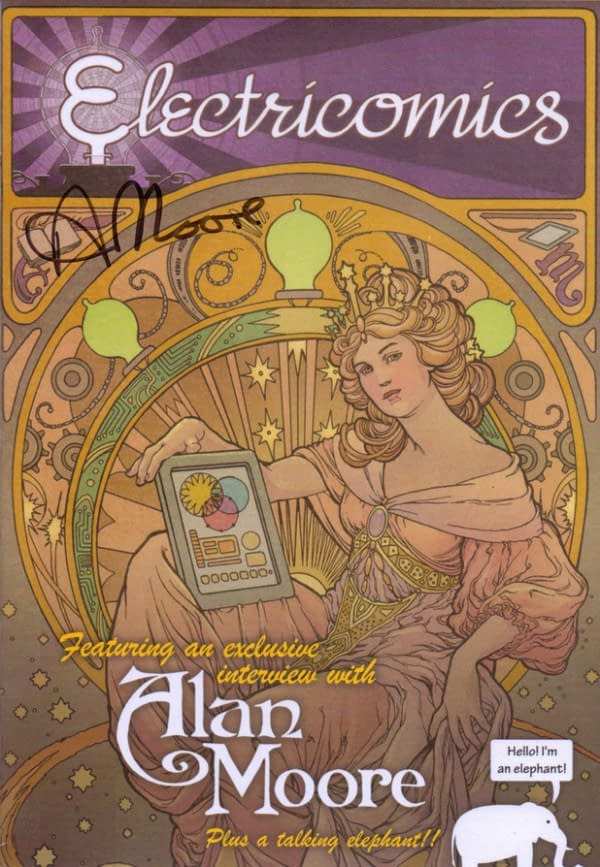
HMS: Well, you're blazing trails in the right direction for use, even if you might only get part of the way. You've prepared the way for the next step for others.
LM: Exactly. There is no loss here either way. To be honest, it feels a bit strange to be sitting here selling print booklets about this amazing new digital thing, but it's about getting our name out there. Because we are relying on community to put their interest out there, we want people to come and play with it and see what they can do with it. That is a big part of our project. Basically, that's why we're here at Thought Bubble is to say, "Hello! We're here!" There are only so many tweets and instagrams a girl can send out and post.
Also, research and development means that the tech guys are sitting in their tech caves doing things that I know nothing about. And they say, "We're just doing these java script libraries". And I say, "Oh, yeah, I know what that means. Right." I can talk to these people at the show about comics.
HMS: I was going to ask you if, working with all these professors and technology minded people has meant that you've had to learn all this terminology that you wouldn't have known otherwise. Or do they try to make it simpler for you?
LM: Oh yes! Daniel [Merlin Goodbrey] says things where I have to say, "What the what?", and get a small dictionary out of my pocket. Iterative processes and all that. And then the tech guys are trying to describe things to me. My role, because I'm the Project Manager, has been to do translation. It's like the Tower of Babel. Comics people are very comics-focused. If you ask someone in comics, "Does this work?", they say, "No. Because, editors do this and that. Publishing works this way". Comics is a very small pond for people who are very specialist and they have their foibles. But tech and research people are exactly the same. Academia is the same in its focus. On the tech side, people say, "Someone is already making something like that". Everybody is up on their own industry. So my job is to see that something is confusing one group of people because they think that it means one thing when it actually means another in another sphere. But it's so much fun.
HMS: Well, it's certainly about learning new things for you.
LM: Definitely. And here, at Thought Bubble, it's really nice to get to talk to the public about it finally, too. I've been to so many meetings, like meeting in London with NESTA and team meetings. I've done interviews by e-mail. But actually being face to face with people, saying, "This is what we're doing. Are you into this?", is quite a relief to be honest. Because you just don't know on the Internet or in meeting rooms, and you're never quite sure if you're shouting into a big void or if someone is actually interested in what you're doing. It's cool.

HMS: You were talking about wanting to be a publisher. Does that mean that Electricomics will eventually be a digital publisher in this format?
LM: We are hoping so. We have the initial four stories that we are publishing to road test the project. But also the comics themselves are being used to get four sets of creators to come up with ideas. My Dad's done his comic, which is obviously "the best and most complicated" because he wouldn't have it any other way. We've all been saying, "Ok, I will just use this one technique", and he's saying, "I will use all the techniques. I will use them on every page". God bless Colleen Doran, who is drawing his Big Nemo comic. She got the script and said, "Right. You do realize that this is like asking a singer to add another octave to their voice?" And I said, "I'm so sorry. Please don't let him break you. I really like you as an artist".
Peter Hogan is doing Cabaret Amygdala which is a kind of showcase horror comic like EC, myself, John Reppion and Nicola Scott are doing the sci-fi one, which is Sway, and Garth Ennis is doing Red Horse with Peter Snejbjerg, which is a World War I set, heartbreaking story. I can't wait for people to read that one. All the best comics make you sad, I think. If you look on my shelf of graphic novels, I think 90% if them actually make me weep. And I think, "I love that so much". I have issues, clearly.
But basically, we are trying to use different techniques and different tools for each comic and approach the comics differently. One of the things we hadn't expected is that Garth, Pete, and my Dad—and I'm going to say this as respectfully as I can—are from a more Golden Age comics generation. They are more established. I think people might have expected us to get more digitally-literate people to do these comics. But actually, what we're doing, by accident, and by complete happenstance, is asking, "What would the older guard of comics do if they were presented with these new-fangled things that they might not know what to do with and are just messing about with?"
Actually, that has turned out to work in our favor, since those are the people we are going to have to convince. People who are already digitally-minded have got their wordpress sites and accounts of various kinds. They'll probably join in once we've gotten it going to see if it's as good as Madefire or other things. But the people who aren't necessarily digitally literate are the people we need to reach, since this is supposed to be for everybody. We want people who are thinking, "I've been writing comics for 30 years. What on earth is all this about?" and let them do it as well.
HMS: It's like you're trying to build a car that can be driven by anyone, so what better to do than have non-drivers involved since they aren't looking for all the fancy things if they are not easily usable.
LM: Yes. On the art side as well, Nicola Scott and Colleen Doran are very much analog artists. Obviously, they both do things online, but they are more hands-on. This cover for the Electricomics booklet was drawn by Colleen with an antique drawing set that was her grandfather's from 1903, that had a crow quill. She inked it with a crow quill. If we are anything, we are antique and wonky, and not slick. When she told me that, I said, "It's perfect. We've got our strange, old-fashioned feel".

HMS: I love that fusion, because you're not somehow ploughing over the past to raze it to the ground in order to build some kind of weird futurism. It's about continuity.
LM: And just making things that look nice, and feel nice, and are nice to read. We want it to be something that people are comfortable with. It's not this alien, unapproachable thing. We aren't saying, "Oh here we are, Electricomics. You might be good enough".
HMS: You don't have to wear space suits and have hover boards to read or use Electricomics…
LM: Exactly. We want people to appreciate that even though it's involving Alan Moore, comic creator extraordinaire, we are definitely not looking down on anybody and saying, "Are you going to be able to do this?" We want people to think, "They seem like a bunch of disorganized maniacs. I could easily do better than that!" [Laughs]. That's our unique selling point!
HMS: I heard Alan Moore talk, a the Show Pieces screening in Leeds, about the little phrase which Electricomics came from, an idea connected to the films, about kids reading comics on a translucent scroll, like a flexible screen. That gives you kind of a tactile sense, like the comics of the past. That's very different from what a super-technologically minded person would come up with. They'd be talking in holographic comics or something like that instead.
LM: We're not even very far from that flexible screen. We were in talks with a company and learned we aren't very far from the flexible, scrolling screen, in terms of technological development as a human race.
HMS: Because screens are liquid anyway? We just need something sturdy.
LM: That's right. They can already make them of a certain size but they can only roll them so much at the moment, though the one that my Dad had imagined was one that you can actually scroll out like a Greek papyrus. Then you've got all the functionality on the scroll. But as he was saying at the screening, he just thinks of these things, and then he makes poor Mitch Jenkins scurry around and bring them into reality somehow by magic [Laughs].
Mitch Jenkins (popping by the table): And he does actually believe they are magic.
Stay tuned for a continuing series of interviews with members of the Electricomics team here on Bleeding Cool about their work, including Mitch Jenkins, Daniel Merlin Woodbrey, and Peter Hogan.
You can learn more about NESTA and the digital arts fund by following them on Twitter @nesta_uk or the hashtag #artsdigital
The Electricomics booklet from Thought Bubble may still be available through the following link in limited numbers.












